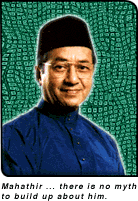|
|

|
 |

 |
22nd March 1998
Recently, I came across an old photograph that reminded me of my association with
powerful people and power that goes back to 44 years ago when I was a house guest
of Datok Abdul Razak bin Hussien in Kuala Lipis during the December school holidays
in 1954.
Forty years on after independence we have had four prime ministers - while Thailand
has had five ministers for the last two years or so - Singapore two prime ministers
in 33 years and Indonesia only two presidents in 53 years.
In Malaysia, as is true also in Singapore, the prime minister, although by convention
is primus inter pares, however in practice, he is not the first amongst equals,
he is all powerful. In Britain, Toni Blair is the first amongst equals as is John
Howard in Australia.
 During the same period in 40 years we have had seven
deputy ministers, Thailand may more - both first and second. Singapore, like Thailand
also maintained the first and second deputy prime ministers. During the same period in 40 years we have had seven
deputy ministers, Thailand may more - both first and second. Singapore, like Thailand
also maintained the first and second deputy prime ministers.
The post of deputy prime minister in Malaysia is a traditional one; it is not a constitutional
appointment which simply means we need not have to have a deputy premier. It depends
on the prime minister and all four prime ministers have used their discretion to
fill the post which amount to being supernumerary or superfluous but, in reality,
I know is absolutely necessary.
To be chosen, the DPM must enjoy the trust of prime minister and a measure of confidence
with the cabinet and the majority party and the coalition and is capable to take
over the administration whenever it is necessary.
Of the seven deputies, Tun Razak, Tun Ismail, Datuk Hussein, Datuk Seri Dr Mahathir
Mohamad, Datuk Musa Hitam, Encik Ghaffar Baba ( now a Tun) and Datuk Seri Anwar Ibrahim,
three eventually become prime minister (Razak, Hussein, Mahathir). Ismail died in
office; Musa quit; Ghaffar dislodged, and; Anwar canters gently although he does
not lack fans who want him to go at a gallop but he has hitherto been wise not to
prance.
There is a great propensity, almost a temptation, to give leaders qualities they
don't posses, however, it does seem that Mahathir is the kind of person who will
be Malaysian history for a long time. There is no myth to build up about Mahathir.
He is what he is.
So far we have had 10 Yang di-Pertuan Agongs. Three died in office - the first King
Tuanku Abdul Rahman, father of the present king, Sultan Hisahmudin of Selangor (died
before he was installed), and Sultan Yahya Petra of Kelantan.
Tunku Abdul Rahman Putra's first choice of paramount ruler was Sultan Ibrahim of
Johor but he declined it. The second most senior ruler, and keen, was the popular
Sultan Abu Bakar of Pahang. However, he was passed over because he married to a ronggeng
girl during the run-up of the election of Agong which made Tuanku Abdul Rahman, Yang
di-Pertuan Besar Negri, a unanimous choice of Conference of Rulers in early 1957.
The unfortunate thing was that the marriage broke down soon after merdeka.
The most senior ruler in Malaysia today is the Raja of Perlis who ascended the Perlis
throne in 1945, two years before I attended formal schooling, and the second longest-serving
sultan is Tuanku Salahuddin Abdul Aziz Shah of Selangor who became ruler in 1960
when I was already a reporter. I interviewed him when he threatened to give up the
title of Raja Muda after merdeka.
The Raja of Perlis, Syed Putra Jamalullail, the only living link at the highest level
we still have who is a primary source of oral history on Malayan Union, which he
signed and which came into being on April 1, 1946 - 16 months after he became Ruler
of Perlis.
The Malay under the leadership of Datuk Onn bin Jaafar, vigorously opposed the formation
of Malayan Union fearing they would be overwhelmed by the Chinese, and succeeded
in replacing the Malayan Union with the Federation of Malaya in 1946 which restored
Malay sovereignty albeit still under Britain colonial administration. Four months
after the Federation of Malaya, the Chinese led the Communist Party started the emergency
which lasted 12 years ending only in 1960. Tunku Abdul Rahman enlarged Malaya to
Malaysia in 1968 incorporating Singapore, Sabah and Sarawak. Over-ambitious Singapore
"voluntary" separated itself from the Federation on Aug. 9, 1965.
Indonesia's Sukarno and Philippines opposed the formation of Malaysia and broke diplomatic
relations with Kuala Lumpur. Jakarta not only broke diplomatic relations but started
a military confrontation which resulted in several skirmishes in Borneo, Mersing
and Pontian. However, by new year 1966, "Konfrontasi", as the Indonesians
called it, slowed down as a result of a new political realignment in Indonesia.
By April, Suharto, who had become the de facto ruler of Indonesia agreed to a reconciliation
between Jakarta and Kuala Lumpur and on June 1, 1966, tun Razak, accompanied by a
high level delegation of 38 persons went to Jakarta to signed the Peace Agreement.
The agreement was signed by Tun Razak and Adam Malik, the new Indonesian foreign
minister, witnessed by Indonesia's new strongman, General Suharto.
Adam, according to agreed script, would accompany Razak, the deputy prime minister,
to KL following the signing ceremony as a gesture of friendship between the malay-speaking
nations and to notify the world that a new era had begun.
|

|
|
|
|